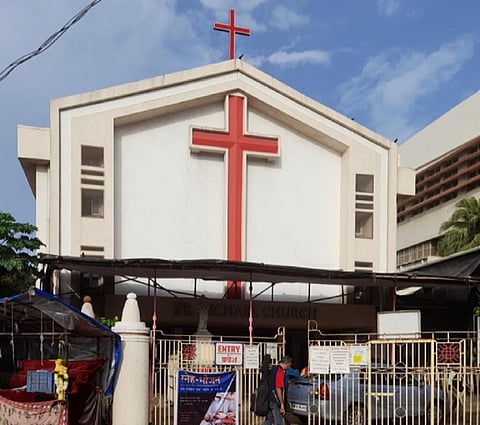

You are not alone if you are frustrated by slow or inadequate government response to the climate crisis. But while the state is the primary driver of climate action, it is not the only one.
Individuals, businesses, civil society organisations and even places of worship can also play a role in addressing the crisis. So, it comes as no surprise that action taken by an iconic church in Mumbai to go carbon-neutral has made headlines.
St Michael Church, known popularly as Mahim Church, is the first place of worship in India to decarbonise.
India has about 2 million temples, 150,000 mosques, 10,000 churches, innumerable gurdwaras, agiaries and other places of worship. The impact will be huge if others follow in the church’s footsteps.
In simple terms, carbon-neutrality means reducing an organisation’s or individual’s carbon footprint to zero through a series of emission-reducing actions.
These can include switching to clean energy and taking public transport instead of a private car. Investing in carbon offsets — such as planting trees on farms or public land — is another way to achieve the neutrality goal. The Mahim church plans to do both.
Founded in 1534 as San Miguel in Portuguese Bombaim (later Bombay and now Mumbai), St Michael’s is one of the oldest churches in the city. It has about 5,000 members and 50,000 devotees attending various services every week.
One of the services — called novenas — attracts people of all faiths, many of whom bring garlands and wax figures of what they desire (for example, a house). The flowers and wax are both recycled.
The church is also a centre for recycling plastic, tetra pak and electronic waste. Its ‘green cell’ has been active in cleaning the nearby Mahim beach.
Recognising its green credentials, the author suggested to Fr Lancy Pinto, the priest-in-charge, that the church should consider becoming carbon neutral.
The priest, who is also a botanist, requested a concept note and an action plan. Installing solar panels on the roof and a biogas digester run on flower waste were a part of it.
The church has a solar coverage of 20 KWh capacity and has a biogas that runs on flower waste. Photos: Oswald Rodrigues
In November last year, a serious effort was made to calculate the church’s carbon footprint. The calculations were verified by Zenith Energy Ltd of Hyderabad, which provides climate consultancy services.
The church’s carbon footprint for 2021 was calculated at 44 tonnes of carbon dioxide equivalent (tCo2e). The emissions were low because of the pandemic, which resulted in the church being closed to the public for most of the year.
Nevertheless, Fr Pinto noted: “The figure is a small amount by world standards, but our effort to reduce this to zero is a big step.”
Electricity consumption contributed 86 per cent to the emissions, while transport footprint was low at 11 per cent, mainly because most of the 30 church employees lived nearby and walked to work.
Going solar was one of the church’s best decisions since Mumbai has one of the highest electricity tariffs in the country. The emission factor for the local grid is also high at 0.91 tCo2e per megawatt hour (MWh) since it relies predominantly on coal. Sadly, solar power is barely noticeable in the city’s power mix as it comprises just 0.7 per cent.
To reduce the emissions to zero, the church will likely expand its solar coverage by a third from the present 20 KWh capacity and invest in community projects to offset the emissions balance.
Fr Pinto said the church is looking into planting trees, supplying smokeless chulhas (stoves), supporting conservation agriculture and building village community biogas systems.
The Mahim church’s pioneering effort at carbon-neutrality has found an echo in other places of worship. A few temples in south India also wish to explore this possibility and a management team will visit the church.
The temples have considered several ideas like solar installations, tree plantation and turning waste into energy. Some have a large annadhanam (free meals for devotees) programme and some turn flowers into biogas to use as fuel in the kitchen.
St Michael’s decision dovetails the Mumbai Climate Action Plan (MCAP), which seeks to achieve neutrality by 2050 — twenty years ahead of India.
MCAP has the support of the Maharashtra government and the Municipal Corporation of Greater Mumbai. A report prepared by World Resources Institute estimated the city’s carbon footprint at 23 million tCO2e in 2019 and set a reduction goal of 30 per cent by 2030.
Additionally, several large Indian corporates have announced plans to reduce their carbon footprint. Indian Railways has a goal of becoming carbon neutral by 2030. Many others are expected to jump on the bandwagon to avert the climate disaster.
Every bit of decarbonisation — big or small — helps.
The author is helping a Gujarat-based charitable trust to achieve neutrality in measured steps as its resources are limited. For flyers, several Indian carriers now provide an option to neutralise emissions while booking their flights.
The least a person or organisation can do is to calculate their carbon footprint to recognise how they are a part of the problem.
As my high school teacher Krishnamurthi used to say: “To be part of the solution, you must first accept you are part of the problem.”
I calculated my emissions and am offsetting these. What about you?
Views expressed are the author’s own and don’t necessarily reflect those of Down To Earth